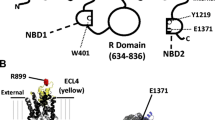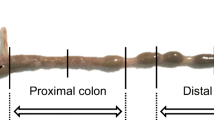Abstract
The secretion of the oxalate anion by intestinal epithelia is a functionally significant component of oxalate homeostasis and hence a relevant factor in the etiology and management of calcium oxalate urolithiasis. To test the hypothesis that human cystic fibrosis transmembrane conductance regulator (hCFTR) can directly mediate the efflux of the oxalate anion, we compared cAMP-stimulated 36Cl−, 14C-oxalate, and 35SO4 2− efflux from Xenopus oocytes expressing hCFTR with water-injected control oocytes. hCFTR-expressing oocytes exhibited a large, reversible cAMP-dependent increase in whole cell conductance measured using a two-electrode voltage clamp and a 13-fold increase in rate of cAMP-stimulated 36Cl− efflux. In contrast, the rate constants of oxalate and sulfate efflux were low and unaffected by cAMP in either control or hCFTR-expressing oocytes. We conclude that the human CFTR gene product does not directly mediate oxalate efflux in secretory epithelia and hence is not directly involved in oxalate homeostasis in humans.




Similar content being viewed by others
References
Costello JF, Smith M, Stolarski C, Sadovnic MJ (1992) Extrarenal clearance of oxalate increases with progression of renal failure in the rat. J Am Soc Nephrol 3:1098–1104
Hatch M, Freel RW, Vaziri ND (1994) Intestinal excretion of oxalate in chronic renal failure. J Am Soc Nephrol 5:1339–1343
Hatch M, Freel RW (2003) Angiotensin II involvement in adaptive enteric oxalate excretion in rats with chronic renal failure induced by hyperoxaluria. Urol Res 31:426–432
Hatch M, Freel RW (2003) Renal and intestinal handling of oxalate following oxalate loading in rats. Am J Nephrol 23:18–26
Hatch M, Cornelius J, Allison M, Sidhu H, Peck A, Freel RW (2006) Oxalobacter sp. reduces urinary oxalate excretion by promoting enteric oxalate secretion. Kidney Int 69:691–698
Hatch M, Freel RW, Vaziri ND (1993) Characteristics of the transport of oxalate and other ions across rabbit proximal colon. Pflugers Arch 423:206–212
Hatch M, Freel RW (2005) Intestinal transport of an obdurate anion: oxalate. Urol Res 33:1–16
Freel RW, Hatch M, Vaziri ND (1998) Conductive pathways for chloride and oxalate in rabbit ileal brush-border membrane vesicles. Am J Physiol 275:C748–C757
Freel RW, Hatch M, Vaziri ND (1997) cAMP-dependent sulfate secretion by the rabbit distal colon: a comparison with electrogenic chloride secretion. Am J Physiol 273:C148–C160
Linsdell P (2006) Mechanism of chloride permeation in the cystic fibrosis transmembrane conductance regulator chloride channel. Exp Physiol 91:123–129
Steward MC, Ishiguro H, Case RM (2005) Mechanisms of bicarbonate secretion in the pancreatic duct. Annu Rev Physiol 67:377–409
Smith SS, Steinle ED, Meyerhoff ME, Dawson DC (1999) Cystic fibrosis transmembrane conductance regulator. Physical basis for lyotropic anion selectivity patterns. J Gen Physiol 114:799–818
Ohrui T, Skach W, Thompson M, Matsumoto-Pon J, Calayag C, Widdicombe JH (1994) Radiotracer studies of cystic fibrosis transmembrane conductance regulator expressed in Xenopus oocytes. Am J Physiol 266:C1586–C1593
Cunningham SA, Worrell RT, Benos DJ, Frizzell RA (1992) cAMP-stimulated ion currents in Xenopus oocytes expressing CFTR cRNA. Am J Physiol 262:C783–C788
McCarty NA (2000) Permeation through the CFTR chloride channel. J Exp Biol 203:1947–1962
Dawson DC, Smith SS, Mansoura MK (1999) CFTR: mechanism of anion conduction. Physiol Rev 79:S47–S75
Linsdell P, Hanrahan JW (1998) Glutathione permeability of CFTR. Am J Physiol 275:C323–C326
Freel RW, Hatch M, Green M, Soleimani M (2006) Ileal oxalate absorption and urinary oxalate excretion are enhanced in Slc26a6 null mice. Am J Physiol Gastrointest Liver Physiol 290:G719–G728
Shcheynikov N, Ko SB, Zeng W, Choi JY, Dorwart MR, Thomas PJ, Muallem S (2006) Regulatory interaction between CFTR and the SLC26 transporters. Novartis Found Symp 273:177–186;discussion 186–192, 261–264
Acknowledgments
Dr. David Dawson (Department of Physiology/Pharmacology, Oregon Health & Science University) kindly provided the wild-type hCFTR cDNA and Dr. M. Green (University of Florida) prepared the cRNA. Amanda Morris assisted in maintenance and surgical procedures. Supported by NIH DK060544 (RWF), DK056245 (MH), and the Oxalosis and Hyperoxaluria Foundation.
Author information
Authors and Affiliations
Corresponding author
Rights and permissions
About this article
Cite this article
Freel, R.W., Hatch, M. Enteric oxalate secretion is not directly mediated by the human CFTR chloride channel. Urol Res 36, 127–131 (2008). https://doi.org/10.1007/s00240-008-0142-8
Received:
Accepted:
Published:
Issue Date:
DOI: https://doi.org/10.1007/s00240-008-0142-8




